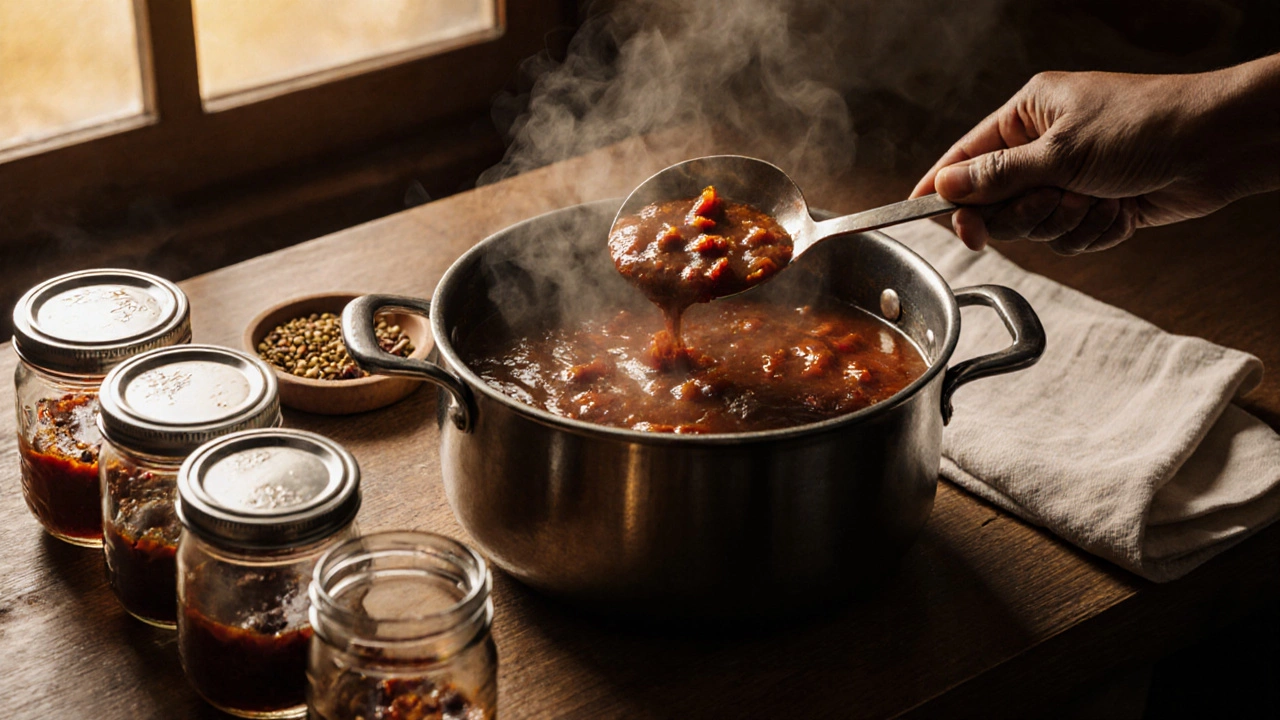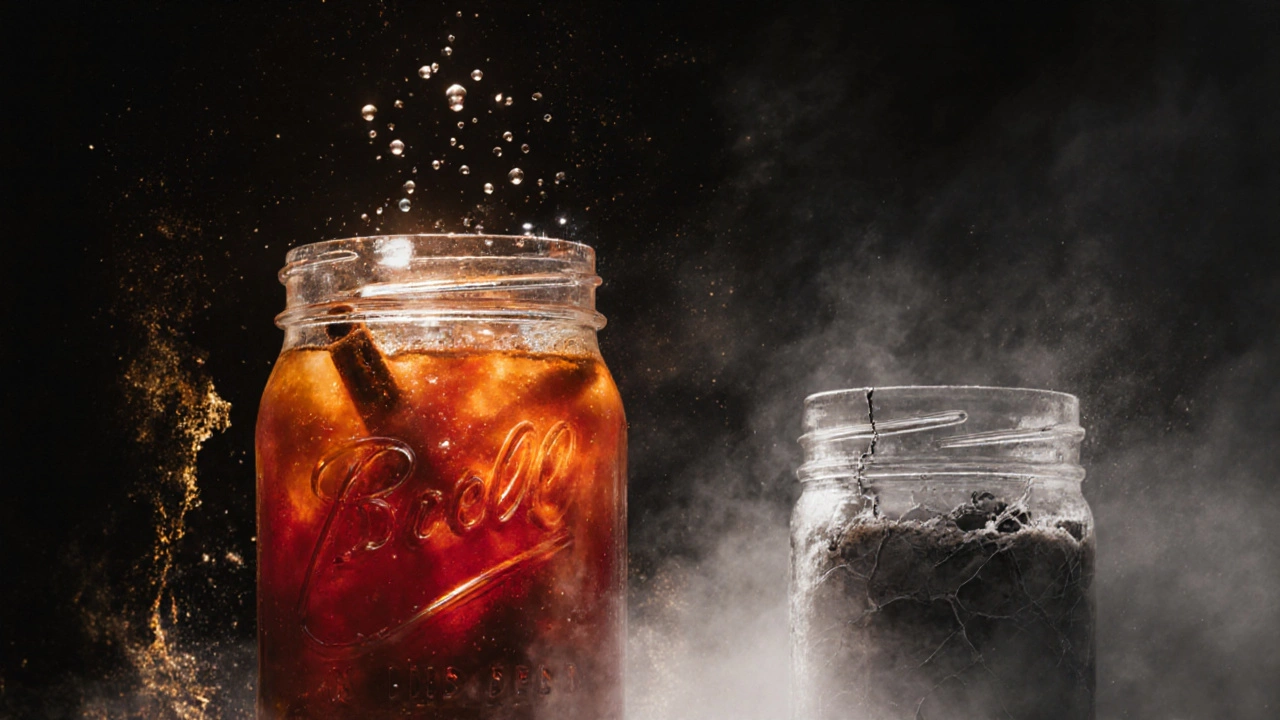
Chutney Shelf-Life Calculator
How to Use
Select your chutney preservation method and storage conditions to see estimated shelf life and safety status.
When you’ve spent hours simmering mangoes, tamarind, and spices into a rich, tangy chutney, the last thing you want is for it to spoil before you even get to use it. The big question that comes up every time someone jars chutney is: Do you jar up chutney hot or cold? The answer isn’t just about tradition-it’s about safety, shelf life, and flavor. Get it wrong, and your chutney could ferment, mold, or lose its punch. Get it right, and it’ll last for months, tasting as fresh as the day you made it.
Why Hot Jarring Matters for Chutney
Hot jarring means filling sterilized jars with chutney while it’s still piping hot-right off the stove. This isn’t just a suggestion; it’s the standard method used in home canning across India, the UK, and beyond. Here’s why it works.
When you pour hot chutney into a hot jar, the heat creates a vacuum seal as it cools. That seal pulls the lid down tightly, blocking air, bacteria, and mold from getting in. Cold chutney won’t do this. It sits in the jar like a soup left on the counter-waiting for trouble.
Studies from the University of California Agriculture and Natural Resources show that acidic foods like chutney (pH below 4.6) are safe for water bath canning-but only if processed while hot. Cold-packed chutney doesn’t reach the internal temperature needed to kill spores, even if it’s vinegar-heavy. That’s why your grandma always warned against letting chutney cool before jarring.
What Happens When You Jar Chutney Cold
Some people think jarring cold chutney is easier. You make it, let it sit overnight, then spoon it into jars. It feels less rushed. But here’s what really happens:
- The chutney contracts as it cools, leaving air pockets in the jar.
- Without heat to drive out oxygen, yeast and mold have a better chance to grow.
- Flavor compounds break down faster in oxygen-rich environments.
- Condensation forms inside the lid, creating a damp zone where bacteria thrive.
I’ve seen this happen in my own kitchen. Last winter, I tried jarring a tamarind-date chutney cold because I was tired. Two weeks later, the top layer turned fuzzy. The rest smelled fine, but I tossed it. No point risking it.
Even if you refrigerate cold-jarred chutney, it won’t last as long. Cold-jarred chutney lasts about 4-6 weeks in the fridge. Hot-jarred chutney? Six months to a year on the shelf-no fridge needed.
How to Jar Chutney the Right Way
Here’s a simple, foolproof method that’s been used in households from Chennai to Birmingham for generations.
- Sterilize your jars. Wash them in hot soapy water, then boil them for 10 minutes. Or run them through a dishwasher on the hottest cycle. Don’t skip this. Even a tiny bit of residue can ruin your batch.
- Keep jars warm. After sterilizing, leave them upside down on a clean towel or place them in a low oven (100°C/212°F) until you’re ready to fill them. Cold jars + hot chutney = cracked glass.
- Fill while hot. As soon as your chutney stops bubbling, ladle it into the warm jars. Leave 1 cm (½ inch) of headspace at the top.
- Wipe the rims. Use a clean, damp cloth to wipe any sticky residue off the jar edges. A clean rim ensures a tight seal.
- Seal immediately. Place sterilized lids and bands on top. Screw them on just until fingertip-tight-don’t crank them down.
- Process in a water bath. Place jars in a large pot of boiling water. Make sure the water covers the jars by at least 2.5 cm (1 inch). Boil for 15 minutes (for chutney, not fruit jams). This step kills any lingering microbes.
- Cool and check seals. Remove jars and let them cool overnight. You’ll hear the satisfying pop as each lid seals. Press the center of the lid-if it doesn’t move, it’s sealed. If it pops up and down, refrigerate and use within a month.

What About Vinegar and Sugar? Do They Make It Safe?
Yes, vinegar lowers pH, and sugar acts as a preservative. But they’re not magic shields. Many traditional chutneys use vinegar (apple cider or white), jaggery, and spices-but they still need heat processing.
Here’s a real example: A 2023 study from the Indian Institute of Food Processing Technology tested 12 homemade chutney recipes. Five were cold-jarred. Three of those developed mold within 30 days, even though they had 5% vinegar and 20% sugar. The seven that were hot-jarred and water-bath processed? All remained safe and flavorful after 12 months.
Don’t assume your chutney is safe just because it tastes sour or sweet. Bacteria don’t care about flavor-they care about temperature and oxygen.
Storage Tips After Jarring
Once your chutney is sealed and cooled:
- Store in a cool, dark place-like a pantry or cupboard. Avoid direct sunlight or heat sources like ovens.
- Label each jar with the date and type. Tomato-tamarind chutney from March 2025? That’s useful when you’re digging through shelves in December.
- Once opened, refrigerate. Use within 6-8 weeks.
- If you see mold, smell off-odors, or notice bubbling inside a sealed jar-throw it out. No second chances.
Some people store chutney in the fridge right away, even if it’s hot-jarred. That’s fine, but it’s not necessary. The heat-processing method makes it shelf-stable. Refrigerating it doesn’t make it safer-it just slows down flavor changes.
Common Mistakes to Avoid
Even experienced cooks mess this up. Here are the top errors I’ve seen:
- Using non-canning jars. Mason jars or Weck jars are designed for pressure and heat. Regular pickle jars? They can crack.
- Reusing old lids. The sealing compound on lids is meant for one use. Reusing them leads to failed seals.
- Overfilling jars. Too little headspace means the chutney expands and pushes the lid off during processing.
- Skipping the water bath. This is the #1 mistake. Boiling the jars after filling isn’t optional-it’s the safety net.
- Assuming all chutneys are the same. Coconut chutney? That’s not meant for long-term storage. It’s meant to be eaten fresh. Not all chutneys are made to be jarred.

Which Chutneys Are Best for Jarring?
Not every chutney holds up to canning. Here’s a quick guide:
- Great for jarring: Mango, tamarind, tomato, onion, garlic, red chili, and mixed spice chutneys. These are acidic, cooked down, and thick.
- Not ideal: Fresh cilantro chutney, mint chutney, coconut chutney, yogurt-based chutneys. These are meant to be eaten within days. They’re too low in acid or contain dairy.
If you love fresh mint chutney, make small batches weekly. Don’t try to preserve it. You’ll be happier with the flavor.
When to Use Your Jars
Once you’ve got your jars sealed, you’ve got a pantry full of flavor. Use them to:
- Top dosas and idlis on rainy mornings.
- Spice up grilled cheese sandwiches or roasted vegetables.
- Stir into lentils for extra tang.
- Gift them in pretty jars with a ribbon-everyone loves homemade chutney.
My favorite way? A spoonful on a plain yogurt bowl with roasted peanuts and a sprinkle of chaat masala. It turns a simple snack into something special.
Can I use plastic lids for chutney jars?
No. Plastic lids don’t create a reliable vacuum seal, especially under heat. Always use metal lids with a rubber sealing ring designed for canning. Plastic may warp, leak, or allow air in over time.
Do I need to sterilize the lids too?
Yes, but you don’t need to boil them. Just wash them in hot soapy water and rinse well. Some manufacturers say you can soak them in hot (not boiling) water for 10 minutes to soften the sealing compound. Check your lid packaging for instructions.
Why does my chutney separate after jarring?
A little oil rising to the top is normal, especially with coconut or mustard oil-based chutneys. Just stir it back in before using. If the whole mixture looks watery or curdled, it may have been undercooked or improperly processed. Discard it if it smells off.
Can I reprocess chutney if I didn’t seal it properly?
Yes, but only within 24 hours. Open the jar, reheat the chutney to boiling, use a new lid, and process again in a water bath. Don’t try to reseal after that-bacteria may have started growing.
Is it safe to store chutney in the freezer instead?
Freezing works for short-term storage-up to 6 months. But it changes texture. Chutney can become grainy or watery after thawing. Hot jarring is better for long-term storage without texture loss. Freeze only if you don’t have jars or plan to use it soon.
Final Thought: It’s Not Just Tradition-It’s Science
People say, ‘We’ve always done it this way.’ And they’re right. But now we know why. Hot jarring isn’t about following old rules. It’s about science-heat, acidity, oxygen, and time. When you jar chutney hot, you’re not just preserving food. You’re locking in flavor, color, and safety.
Next time you make a batch, don’t rush. Let it simmer, let it cool just enough to handle, then fill those jars while it’s still singing hot. Your future self-eating that chutney on a cold January morning-will thank you.